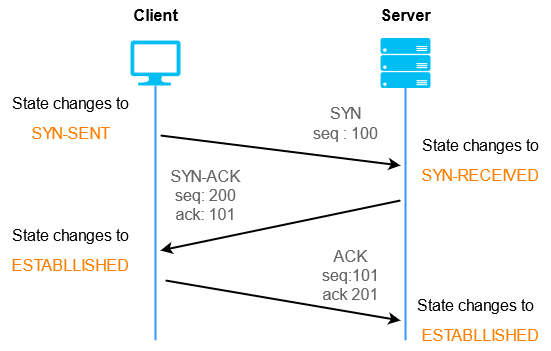
Three-Way Handshaking
April 22,2024In the realm of computer networking, establishing a reliable connection between devices is crucial for seamless data transmission. One of the fundamental techniques used for this purpose is the Three-Way Handshake. In this guide, we'll delve into the intricacies of Three-Way Handshaking, exploring its significance and the steps involved in establishing a TCP connection.
Understanding Three-Way Handshaking
Three-Way Handshaking is a process used by the TCP (Transmission Control Protocol) to establish a connection between a client and a server before data exchange begins.
This handshake ensures that both parties agree to communicate and synchronize certain parameters before initiating data transmission.
Let's explore each step of the Three-Way Handshake:
Step 1: SYN (Synchronize)
Client Sends SYN: The process commences with the client sending a SYN packet to the server. This packet contains a sequence number, which is a randomly chosen value by the client to initiate the connection. The sequence number is crucial for synchronizing data transmission between the client and server.
Step 2: SYN-ACK (Synchronize-Acknowledgment)
Server Responds with SYN-ACK: Upon receiving the SYN packet from the client, the server responds with a SYN-ACK packet. In this packet, the server acknowledges the client's SYN packet by incrementing the client's sequence number by one and choosing its own sequence number for the connection. The SYN-ACK packet indicates that the server agrees to establish a connection and includes its own sequence number.
Step 3: ACK (Acknowledgment)
Client Acknowledges SYN-ACK:Finally, the client acknowledges the server's SYN-ACK packet by sending an ACK packet. The client increments both its own sequence number and the server's sequence number by one, confirming the establishment of the TCP connection. At this point, both client and server are synchronized and ready to exchange data.

Importance of Three-Way Handshaking
The Three-Way Handshake serves several critical purposes in TCP/IP communication:
- Reliable Connection Establishment: By exchanging SYN and SYN-ACK packets, the client and server verify each other's availability and agreement to communicate, ensuring a reliable connection.
- Synchronization of Sequence Numbers: The exchange of sequence numbers during the handshake allows both parties to synchronize their data transmission, preventing issues such as data corruption and packet loss.
- Error Detection and Correction: The acknowledgment mechanism in the Three-Way Handshake enables error detection and retransmission of lost packets, enhancing the reliability of data transmission.
Conclusion
In conclusion, Three-Way Handshaking is a fundamental process in TCP/IP networking, facilitating the establishment of reliable connections between devices. By following the SYN, SYN-ACK, and ACK sequence, the client and server synchronize their parameters and agree to communicate, ensuring seamless data transmission. Understanding Three-Way Handshaking is essential for network engineers and developers to build robust and efficient communication systems in the digital age.
Stay tuned for more insights into networking protocols and techniques in our upcoming posts!